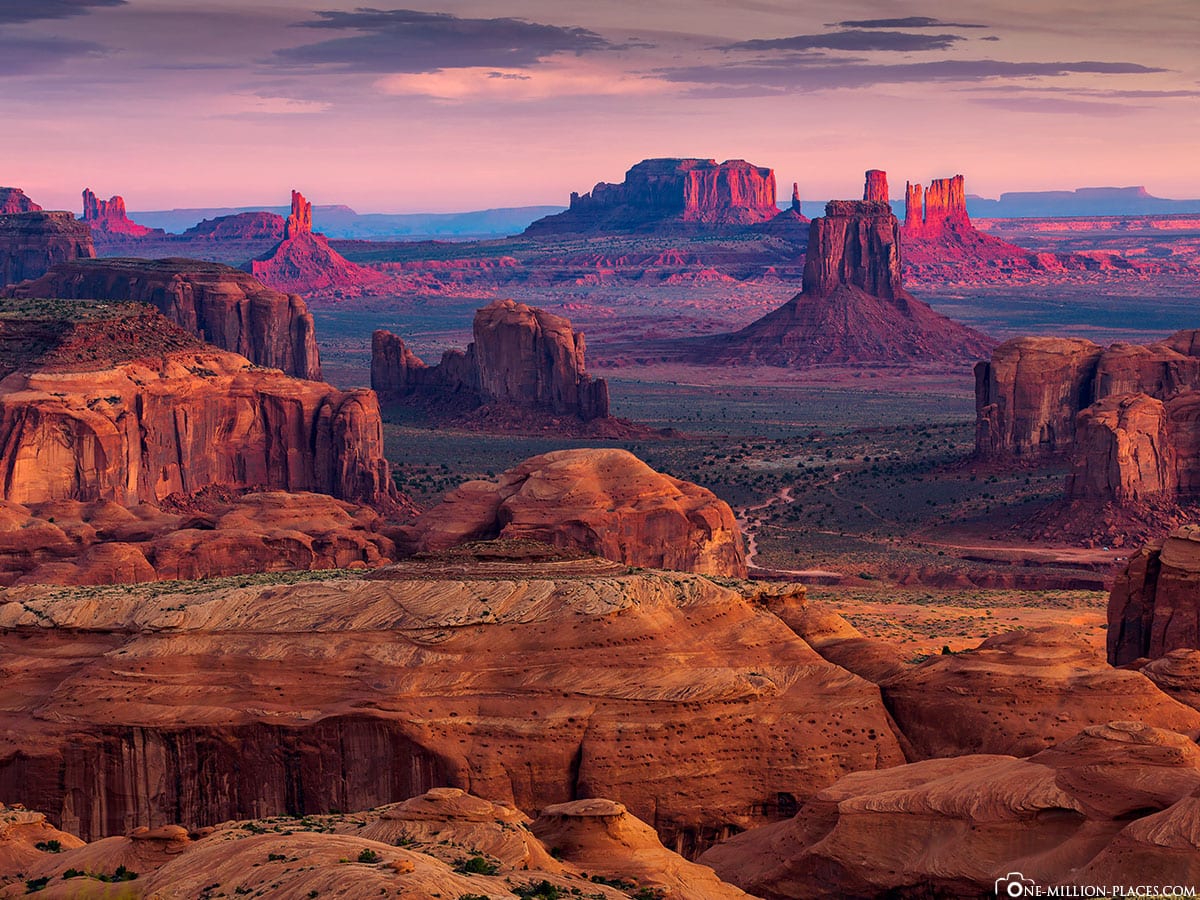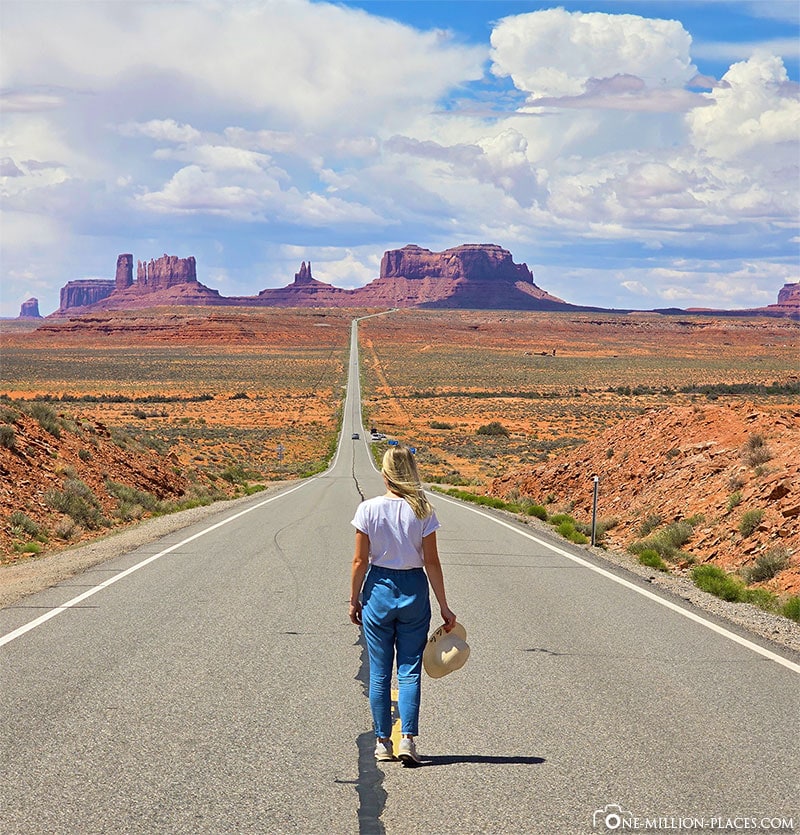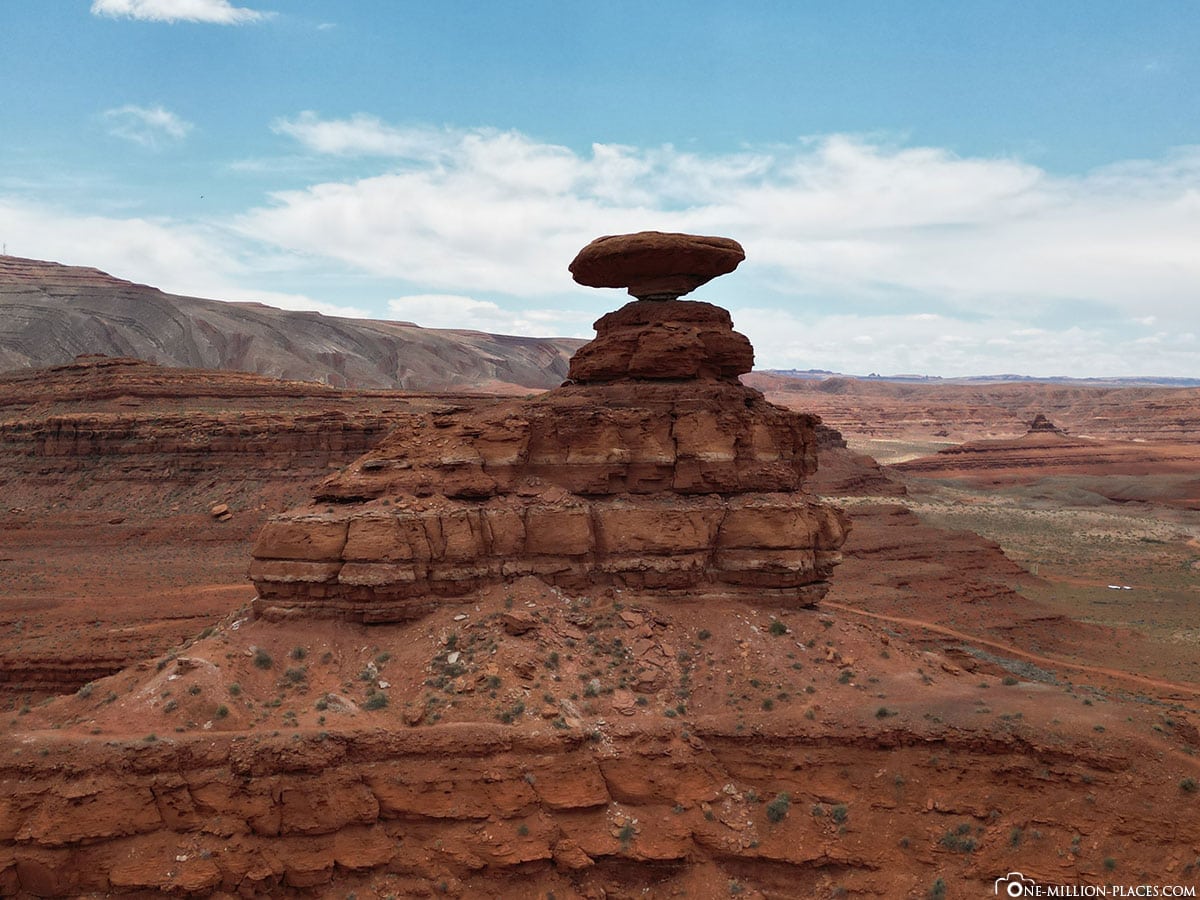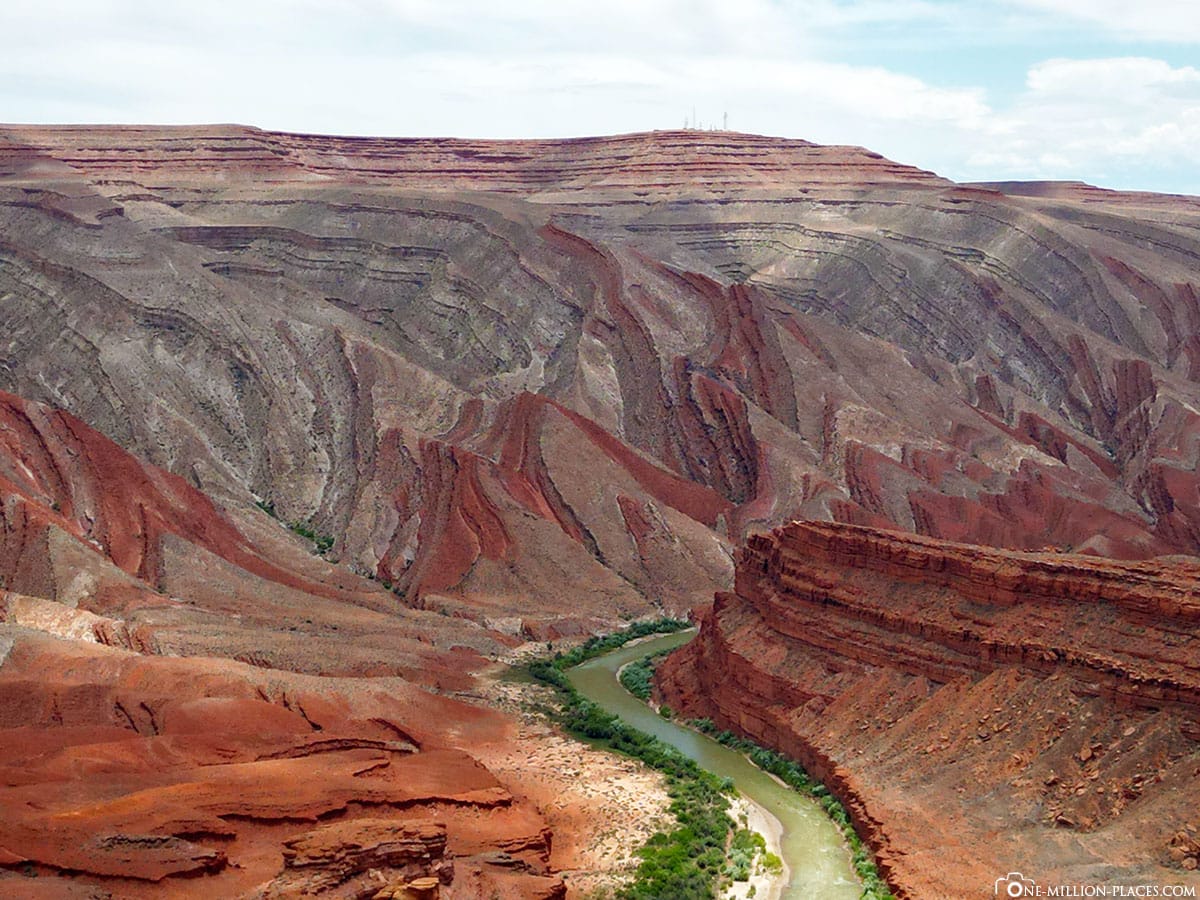Monument Valley was another highlight on our trip through the Midwest of the USA. We have seen the sight of the huge rock formations on the Colorado Plateau so often in pictures or on television. We were therefore very much looking forward to seeing this panorama with our own eyes. You can find out whether it was worth it in our travel report.

Table of contents
Things to know about Monument Valley
Monument Valley is located on the border between the US states of Arizona and Utah and is known for its striking sandstone formations that rise majestically out of the desert. The area is part of the Navajo Nation reservation and is referred to by the Navajo as “Tsé Biiʼ Ndzisgaii”, which means “Valley of the Rocks”. Due to its spectacular landscape, Monument Valley has often been the setting for western films and is considered the epitome of the American West.
The history of the formation of Monument Valley is also very interesting: around 250 to 300 million years ago, the area that today forms Monument Valley was covered by a shallow sea. Over millions of years, large quantities of sediments such as sand, mud and clay were deposited in this sea. These sedimentary layers solidified over time through pressure and chemical processes to form sandstone, limestone and slate. About 65 million years ago, with the rise of the Colorado Plateau, the area began to emerge from the sea. Tectonic forces caused the region to rise and the water to retreat. In the millions of years that followed, wind and water shaped the landscape through erosion. Rivers cut through the layers and carried away soft materials, while harder layers resisted and remained as high mesas, buttes and other distinctive formations. Today’s rock formations are the remains of these once much higher plateaus.
Monument Valley is not only a geological wonder, but also a place of rich cultural significance. For the Navajo, the valley is sacred and plays a central role in their history and mythology. Visitors can explore the area on guided tours, often led by Navajo guides, to learn more about the cultural and spiritual significance of the land. In addition to the well-known rock formations, Monument Valley is also home to petroglyphs and other archaeological sites that offer insights into the long history of the indigenous peoples of the region.
The plateau lies at an altitude of almost 1,900 meters. Temperatures vary between -3 °C in winter and an average of 30 °C in summer.
Forrest Gump Point
We drove northeast from Arches National Park to Monument Valley. That’s perfect, because then you automatically pass Forrest Gump Point🙂
Forrest Gump Point is one of the most famous and most photographed spots in Monument Valley. It is located outside the national park on US Route 163, about 20 kilometers (12 miles) north of the entrance to Monument Valley Navajo Tribal Park (location in Google Maps). The town was made famous by the 1994 movie “Forrest Gump”. In one scene, the main character, played by Tom Hanks, runs a long distance across the USA and reaches this point. After running for several years, he stops at this point, turns to his fellow runners and suddenly decides that he has run enough and ends his journey. Since then, this section of the road has been known as “Forrest Gump Point”.
TIP: If you want to watch the movie scene from Forrest Gump again, you can take a look on YouTube.
From this point, you have an impressive view of the long, straight road that winds its way south through the valley, with the striking rock formations of Monument Valley in the background.
The closer you get to the valley, the more photo opportunities there are.
Opening hours & admission
Monument Valley is open all year round, except for the Thanksgiving, Christmas & New Year holidays. In the summer months (May to September), the visitor center and access to the Scenic Drive are open from 7 am to 7 pm, with the last admission at 4.30 pm. In the winter months (October to April), the visitor center and access to the Scenic Drive are open from 8 am to 5 pm, with the last admission at 2.30 pm.
Admission costs USD 8 per adult per day, children under 8 are free. It is important to know that national passes such as the America the Beautiful Pass are unfortunately not valid here.
Visitor Center, Hotel & Parking
The Visitor Center is the central point of contact for visitors to the Monument Valley Navajo Tribal Park. It is located directly at the entrance to the park, offers a large free parking lot and the following facilities:
– Exhibits: The Visitor Center has exhibits that highlight the geology, history and culture of Monument Valley and the Navajo Nation.
– Souvenir store: Here visitors can buy authentic Navajo art, jewelry, clothing and other souvenirs.
– Restaurant: There is a restaurant serving traditional Navajo dishes as well as Western cuisine.
– Viewpoint: The visitor center offers a fantastic view of the valley, especially of the famous rock formations.
– Guided tours: Booking of guided tours through Monument Valley
If you want to stay overnight directly in the park, there are 3 options: either at The View Hotel, in the Premium Cabins or at The View Campground. You can find more information about this on the park’s official website. As these are the only accommodation options within the park, the prices are correspondingly high. In the summer months, a room at the View Hotel usually costs between 300 and 400 USD.
When we visited, everything was already fully booked. So we looked for a hotel in the area and finally decided on the Kayenta Monument Valley Inn, which is about 30 minutes from the park.
View from the visitor terrace
From the viewing platform at the Visitor Center, you have a great view of the world-famous panorama with Sentinel Mesa, West Mitten Butte, East Mitten Butte and Merrick Butte.
Scenic Drive
The Scenic Drive in Monument Valley is a 27-kilometer (17-mile) dirt road that leads to the valley’s most famous and impressive formations. You should plan two to four hours for the whole Scenic Drive.
The road is unpaved and can be bumpy in some places, which is why four-wheel drive vehicles are recommended. As a rule, however, the road is also passable with a normal vehicle as long as the conditions are good. During our visit, it had rained heavily the days before with localized flooding. Accordingly, the condition of the Scenic Drive was pretty bad. We drove a few meters with our rental car (van) along the Scenic Drive, but then turned around quite quickly 🙁
These are the sights along the Scenic Drive that we would have liked to see closer:
– West Mitten Butte and East Mitten Butte: These iconic rocks are often the first stop on the Scenic Drive and offer fantastic views.
– John Ford’s Point: This viewpoint, named after the famous western director John Ford, is another highlight and offers a spectacular panoramic view of the valley.
– Totem Pole and Yei Bi Chei: These slender rock needles are a popular photo motif.
– Three Sisters: This formation looks like three slender figures standing next to each other and is one of the most photographed sights in the valley.
– Artist’s Point: This point offers a sweeping view over the valley and the surrounding rock formations.
Guided tours
If you don’t have the opportunity to drive the Scenic Drive in your car, you can also book a guided tour. These tours, mostly offered by the Navajo people, provide access to areas that are closed to the general public and allow a deeper insight into the history and culture of the Navajo people. These mostly 3-hour tours usually cost between 60 and 100 USD per person. GetYourGuide has several providers and tours to choose from.
Is a visit to Monument Valley worthwhile?
Generally YES, but there are a few restrictions for us 😉
The view of Monument Valley is world-famous and we have seen it so often on television. So it was clear to us that we wanted to see this with our own eyes. And the view really is so gigantic! Now the “BUT”… From our point of view, there’s not really much more to see than this view. Compared to the other national parks we have already visited, such as Yellowstone National Park, Arches National Park or Yosemite National Park, there is relatively little to discover. Sure, we couldn’t drive the Scenic Drive, perhaps that would have given us a different impression.
It’s just this one view, and it’s really gigantic!
Mexican Hat Rock & Striped Mountains
If you’re in Monument Valley, we can recommend two more cool photo spots: Mexican Hat Rock and the Striped Mountains.
Mexican Hat Rock is a striking rock formation near the small town of Mexican Hat in southeastern Utah (location in Google Maps), about 40 kilometers from Tribal Park. The formation is named after its characteristic shape, which is reminiscent of a traditional Mexican sombrero (hat). The “hat” itself is about 18 meters (60 feet) wide and rests on a pedestal about 15 meters (50 feet) high. A mega photo motif!
But what we found almost more impressive were the zig-zag shaped colored mountains (Striped Mountains), which are located behind the Mexican Rock Hat along the San Juan River. We’ve never seen it like this before and we think it’s a great photo motif!






